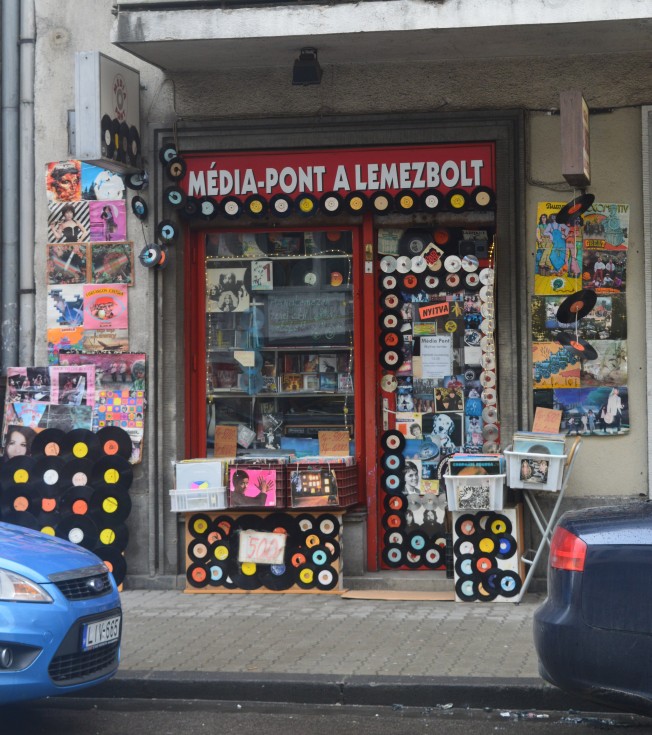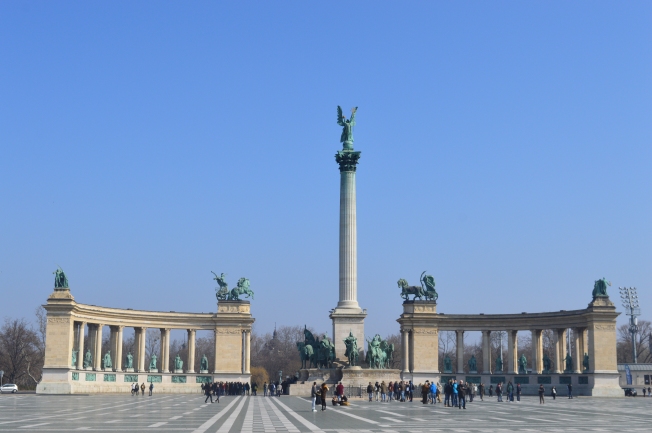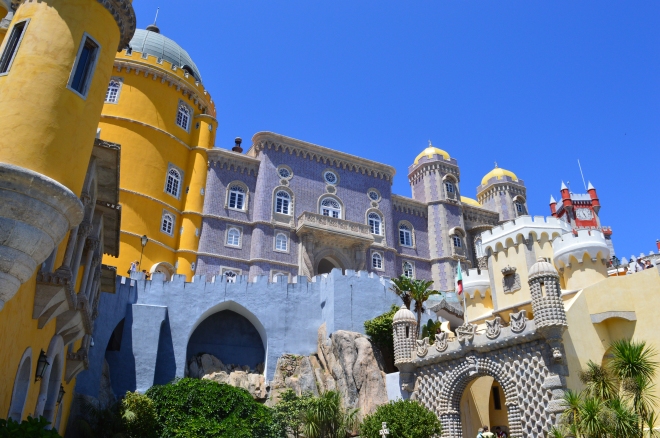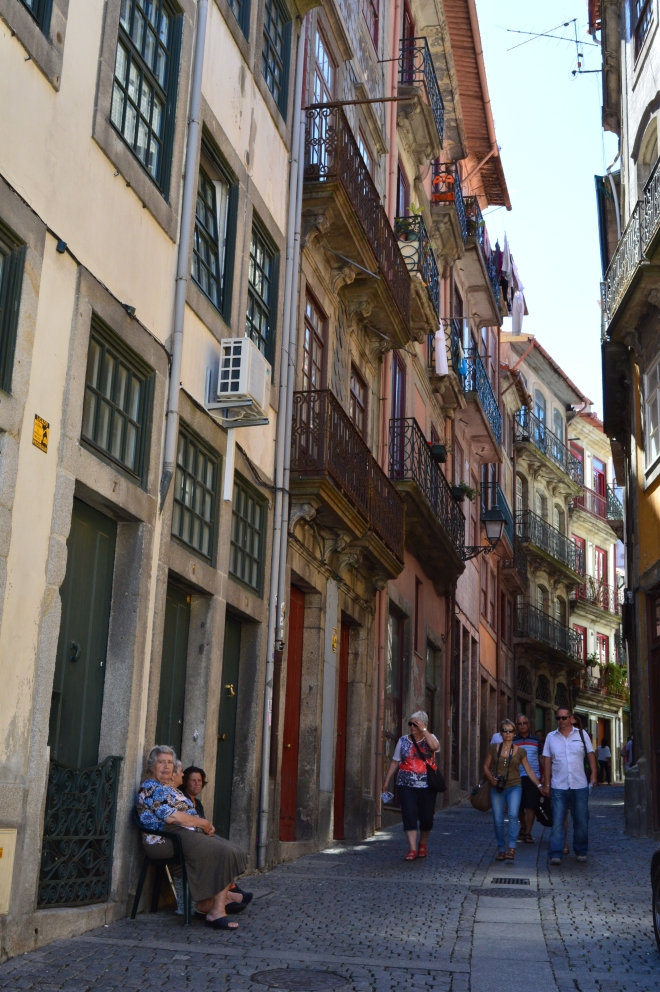The first time I saw photos of Cartagena de Indias, the port city on Colombia’s Caribbean coast, I knew I wanted to visit one day. Although Colombia wasn’t initially in our honeymoon plans, a deal on flights convinced me to visit South America for the first time, and my husband was up for the adventure.
Previously considered one of the most important ports for trade during the Spanish imperial era, Cartagena declared independence from Spain on November 11th, 1811. It is most famous for its historic walled city, the picturesque architecture of which earned it its status as a UNESCO World Heritage Site in 1984.
On every blog I had read about Cartagena, pretty much the same advice was given: October is part of the rainy season, so it’s best not to visit at that time of year. We went against this advice and arrived in mid-October. As we stepped off the plane at Rafael Núñez International Airport, bright sunshine made us cover our eyes and a blazing heat caused us to swiftly remove our sweaters. For the three nights we stayed in Cartagena, we wouldn’t see a drop of rain. Some would call this luck, others would call it climate change.
We caught a yellow taxi into the city centre. It’s about a 10-minute drive, with ocean views on the right. We watched, silenced with astonishment, as cars zoomed chaotically along the highway, narrowly avoiding mopeds that darted in between the lanes. Most of the mopeds carried female passengers on the back. They held on loosely, seemingly unworried as their driver sharply changed lanes without a glance over his shoulder. Signalling doesn’t seem to be a thing here; instead, drivers will frequently toot their horns as if to say, “Move it, I’m coming through.”
Approaching the history city walls, we passed Las Bóvedas, a former dungeon converted into a market. Entrance to the old town was through narrow archways. Traffic-wise, it was every man for himself. Cars from all directions bunched up, beeping incessantly, trying to be the first to go through. “Right of way” didn’t appear to be a concept!
We drove up narrow, cobbled streets, passing pastel-coloured houses with flowers draping around balusters and vine plants spreading along the walls. Our driver mumbled to himself as he tried to find our hotel, and then made a satisfied sound after recognizing the Hotel Casa del Curato on Carrera 7.
Taxis in Cartagena don’t have meters. Some drivers will let you know what the cost will be at the beginning; others seem to wait to see what is offered and then let you know if it’s enough. I handed our driver 25,000 pesos and he looked very happy, which made me wonder if I gave more than necessary…
As we retrieved our bags, a man approached my husband rapping a song. I had read about these artists on a few blogs, all of which had advised to avoid engaging with them because they would ask for money. I had shared this with hubby in advance, alas, this appeared to be forgotten as he shook the man’s hand with a smile and answered when asked which country we were from. Soon after came the man’s open hand and a request. I watched, half irritated, half amused, as a look of realization swept across hubby’s face. Thankfully, a sweet doorman from our hotel came to the rescue and gestured us up the steps inside.
We walked into a cool lobby dotted with various plants. A house cat peeked out curiously from behind a pot. After checking in, we walked up the wooden stairs past a beautiful painting of a Caribbean woman. Our room was bright and airy, with white walls and a balcony that looked onto the street below.
I chose Casa del Curato because it seemed to be located in a slightly quieter part of town, and I have a fondness for independent, boutique hotels. It certainly had a lovely character, and it was cheaper than many hotels in the city, but as a 3-star hotel I also didn’t feel it was quite worth the approximately $200 CAD a night. I reminded my frugal self that we were on honeymoon and let it go.
Freshly changed, we walked down the street, passing the Iglesia de Santo Toribio at a junction on our right. We quickly learned that vehicles were not inclined to give way to pedestrians. On Calle de la Tablada, we turned left and crossed a few blocks until we came to La Mulata. This Carribbean restaurant had been recommended on a blog I read, and we were keen to try to some local food. A sweet lady brought us a complimentary bowl of soup as we glugged water, sweating heavily after only seven minutes of walking. We ate delicious fried fish and coconut rice before bracing ourselves for the humidity of outside once more.
As we walked south down Carrera 7, we saw vendors frying empanadas and stalls selling mangoes, melons and bananas. This street leads to the Plaza de los Coches, in which stands the Monumento Torre del Reloj – a stone gateway with a spiral clocktower. The square was buzzing with tourists. A long arcade ran under a row of colourful buildings, with vendors hoping to tempt tourists with jewellery and crafts. We followed the street as it wound to the right and came to the quieter Plaza de la Aduana.

Continuing along Calle 32, the Santuario de San Pedro Claver caught our attention with its double steeple and old stone architecture. The church blended nicely with the bright yellow of the fancy Hotel Casa San Pedro.

We turned right up the Calle del Landrimal. The street thronged with people as we approached the Plaza de Bolívar. Buskers played in front of park walls painted with beautiful murals and street vendors walked around looking for customers. A Caribbean lady who looked to be in her late 70s smiled gently at the tourists, gesturing with weathered hands at her cart of paper fans. She was quieter than most of the vendors around her, but her presence stood out the strongest to me.
Some of the blogs I’d read about Cartagena had talked of feeling harassed by street vendors and vulnerable to mugging. We prepared for this through the standard travel practice of only carrying the money we needed and wearing money belts under our clothes, and used common sense in not having phones or cameras on show. Some might argue that having a strong man with me helped, but I can truthfully say that as a relatively good-looking woman with naturally very blonde hair, and having experienced a fair amount of street harassment (mostly while living in London), I did not feel unsafe nor harassed in Cartagena. (In fact, this was the case during my entire experience in Colombia.) Street vendors would approach with enthusiastic greetings trying to sell their items, but we found that a polite “Non, gracias” and a gently raised hand to wave them off was enough to prevent them persisting. I would describe the vendors as relentless in their attempts to earn a living, but respectful.
We turned left down the Calle de la Inquisición and then right up Carerra 3. The street led us to the Plaza de Santo Domingo in which we saw a monastery that dates back to the 17th Century.

Continuing along this street, we eventually came to the city wall. I climbed up and took in the ocean view. I knew it would be a great place to watch the sunset, but I wasn’t sure we’d be able to last that long; we had been sipping from a water bottle but the heat and humidity was giving us a light headache.
We joined the Calle de Don Sancho, grateful for the slight shade it offered. The stunning Catedral de Santa Catalina de Alejandría rose up ahead. Hearing hooves clip-clopping behind us, we stepped aside to let a carriage pass, led by a lean horse. Caribbean women wearing brightly patterned dresses sat relaxing in a patch of shade. They can be seen around the walled city selling fruit which they carry on baskets on their heads.

After passing the cathedral, we lost our sense of direction. We never bother buying data plans for our phone when overseas, and the Google Maps on my phone was not in sync. After wandering around for 10 minutes with no luck and a decreasing amount of patience, we approached a group of male police officers. I greeted one of them in Spanish. He responded with a smile and pointed us in the right direction to our hotel. We walked up the steps of Casa del Curato drenched in sweat.
After a cold shower and quick nap, we headed out for dinner. Horses trotted briskly through the streets, leading carriages. Located just up from our hotel, La Cevichería was a seafood restaurant I’d read good things about. We took a seat outside, wanting to be away from the noise of indoors. It’s generally advised not to drink tap water in Cartagena, so I prepared to order two bottles. Looking at the menu, I noticed that a bottle of mineral water cost 1000 pesos more than a pint of beer.
As we waited for our food, a street entertainer dressed as Michael Jackson arrived and set up a small stage on the sidewalk in front of us. Hubby and I glanced at each other, wondering if we should have sat inside afterall. The opening to ‘Thriller’ started loudly, startling us in our seats. As the entertainer broke into dance, we looked down at our food, not wanting to get his attention as he hip-thrusted and shamoned away. Our waiter watched from the doorway and grinned at us, evidently expecting that we would enjoy the loud music and random shrieks of “hee-hee!” I wished he had given us a warning.
After finishing his performance, the impersonator approached the diners outside the restaurant and asked for money. I grimaced as he came to our table. My husband quietly shook his head and apologized. I felt awful because this man was just trying to earn a living, but we had not wanted nor asked for what was ultimately a distraction to our dinner.
Upon viewing our bill, my eyes widened with surprise. At 160,000 pesos, it was more than I expected. A tip had automatically been added, and it didn’t seem justified for a disrupted dinner of a dish that was too salty and seafood that tasted like it had just been heated up out of the freezer. Having anticipated paying 120,000 pesos maximum, I had to dash back to our hotel to get more cash from the safe. We left the restaurant disappointed, feeling like we had been ripped off.
After a great sleep, we got up early. Somehow understanding my jumbled Spanish, the ladies in the hotel kitchen kindly gave us a banana and refilled our water bottle, before we strolled down Carrera 7 to Muelle de la Bodeguita. Keen for a day of swimming in the ocean, we had booked a day tour to one of the Rosario Islands. An archipelago about 36 kilometres southwest of Cartagena, the Islas del Rosario consist of 27 small islands. For a fair price of $200, our tour included the return boat transportation to Islabela Eco Hotel on Isla Marina, plus a welcome cocktail, beach bed (no worrying about others taking yours!), and lunch.
After boarding the boat, we were given lifejackets and the captain gave a briefing in Spanish. As we slowly passed through the harbour, hubby observed with interest a navy ship that carried the Finnish flag. The boat began to pick up speed as we entered wide ocean. Soaring through the sky were slender dark birds with long wings that formed an interesting shape. Looking like pterodactyls from the dinosaur age, they were quite fascinating to watch.
During the one-hour journey, I watched the water hoping to catch sight of some dolphins. Flying fish sparkled in the air as they dove up from the surface. Eventually we came to a small bay with turquoise-blue water. Friendly staff greeted us as we walked towards a collection of rustic umbrellas standing over beach beds in front of a small sandy beach. We dove in the ocean as fast as we could, and it was delightful. For lunch we had fried red snapper and coconut rice with salad, accompanied by a large jug of delicious iced tea. Tour participants had the option to pay extra to go snorkelling with a guide, but we were conscious of funds and felt content with doing our own thing.
The day was so relaxing and a welcome change of pace to balance out the hustle and bustle of Cartagena’s walled city. We spent a lot of time in the ocean, wanting to make the most of the opportunity to experience the warm Caribbean Sea. I observed an American couple avoid the water, instead taking work calls on their beach bed as a waiter from the resort brought them a burger and fries. It seemed like such a waste.
At 3 p.m., a bell signalled that it was time for us to return to the boat. The sun was starting to lower in the sky as we made our way back to Cartagena. Hearing the word “propina” in his final comments, I gave the boat captain a small tip and we headed back to our hotel.
A stage had been set up in the Plaza de los Coches and a crowd was starting to form. As we walked up Carrera 7, we heard singing and drums beating. On approach to our hotel, a colourful procession came down the street, dancing and smiling as onlookers cheered and clapped. Our doorman was standing on the steps of the hotel, watching. I asked him what was happening. It was difficult to hear him above the noise, but I heard the word “carnaval.” I hurried upstairs to the balcony of our room and watched, entranced, as women wearing dresses with bold colours and vivid patterns danced in tandem, twirling in circles and swishing their skirts.
I had one of the best views in the house and I wasn’t even sure what it was for. But a quick bit of research told me that students from local colleges were participating in a cultural week – early festivities ahead of the official celebrations that take place each November to commemorate Cartagena’s declaration of independence from Spain. I felt so lucky to witness this special event, filled with vibrant colours and joyful faces. It was probably the highlight of my time in Cartagena!
The next day, we left Cartagena and travelled south-east to the small town of Santa Cruz de Mompox, before returning to Cartagena two days later. As we re-entered the city on a Sunday afternoon, I watched through my window as a lady around my age with crooked posture collected glass bottles and tin cans from a garbage bin and put them in a bag. Her son sat nearby, looking no older than five years old. He picked up an empty plastic Starbucks cup from the pavement and played with it in his hands, as if it were a toy. I looked away with a pulling in my chest, picturing children in Canada with their pretty dolls and shiny lego.
Our hotel for the third night of our stay in Cartagena was Hotel 3 Banderas, one block east from Casa del Curato. It stood on a pretty street of pastel-coloured houses and hanging blooms.
Wanting to avoid any overpriced restaurants, we went for tacos at Los Tacos del Gordo – a small, casual eatery on Carrera 7. We then wandered down to the Parque Centenario where we were fortunate to see several marmosets in the trees, scampering along branches playfully. Someone told us there were a couple of sloths in the park as well, but they are notoriously difficult to see without binoculars.
After spending several minutes admiring the monkeys, we walked out the opposite end of the park and down Calle 31. We were now in the neighbourhood of Getsemani, described on a few blogs I’d read as the somewhat grungier, more “hipster” part of the city. I went in with an open mind but did agree it had a slightly rougher feel to it, similar to looking at London, England, and comparing Peckham with Covent Garden.
A portion of Calle 31 is known as Calle de Las Sombrillas because of the canopy of umbrellas that hang above the street. There are a few of these streets in the neighbourhood, and as you can imagine, they are very popular with Instagram lovers.
Rappers made rhymes as we walked up streets showcasing colourful artwork. After taking a look at the Plaza de la Trinidad, we headed back down through the Parque Centenario (the monkeys were too cute to not see again!). The Torre del Reloj was still surrounded by tourists as we made our way back to our hotel.
We woke early on our final morning in Cartagena, prepared for an upcoming flight to Panama City. A decision to take a final stroll of the hotspots turned out to be an excellent choice, because at 7 a.m., the city was empty. No tourists, no vendors. We revisited some of the places we had passed by previously, this time able to take a longer look. With no disruptions and a more tolerable temperature, we could greater appreciate the beauty of the architecure and art work inside this walled city.
Grateful for an unexpected 30 minutes of peaceful exploring, we returned to our hotel to pack up our things before heading to the airport. I left Cartagena glad that I got to see it for my own eyes, but reminded that there is always more to a city than what the photos show.
Cartagena was a vibrant city painted with various colours. The walled city was abundant with rich, happy tones – sights that most tourists would see and remember. But it was also speckled with muddy spots – small details that some tourists wouldn’t notice, but that caught my eye and were hard to forget. And on the outskirts of this tourist haven was a greyer canvas that illustrated scenes of struggle and misfortune.
Price-wise, Cartagena was a city that seemed to take advantage of its popularity with tourists. This left me conflicted – in some ways frustrated; in others, mindful that the residents here don’t have much. The prevalence of street vendors caused a complex array of emotions – sometimes sympathy, sometimes annoyance, sometimes sadness. But the strongest emotion was probably admiration, for their tenacity to keep doing what they could to provide for themselves and their families.
A few bloggers I’d read had said Cartagena was not their favourite place to visit in Colombia, and after my own experience, I can say I feel the same. I do not regret visiting it at all; it’s a vibrant city with a Caribbean culture that permeates through the streets, and overall I enjoyed witnessing the different customs and ways of life. The architecture within the walled city is beautiful and certainly worth seeing, and a trip (ideally an extended one) to the lovely Rosario Islands is a must if in the area. However, in any country, the most touristic cities generally do not give the most authentic representation of a country’s culture. To get a better glimpse of the “real” Colombia, it would be wise to combine a visit to Cartagena with time in smaller, quieter towns and communities.
*
Did you find this article useful? Click here if you’d like to download a GPS-coordinated version from the GPSMyCity app for reference during your visit to Cartagena.
































































































